Because she’s a very fit and gifted runner and triathlete, unlike most others! Simple and true. The blog below was written by Sami Inkinen, 4th place in the Ironman 2013 World Championships M35-39 with a sub 9hr race. He also crushed the 2013 Eagleman 70.3 race winning the amateur race in 4hrs 5mins.
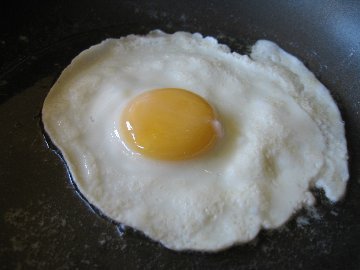 This could be your body at Hawaii Ironman triathlon.
This could be your body at Hawaii Ironman triathlon.
However, there are a few fundamental factors that change the limits of endurance performance at the Hawaii Ironman triathlon significantly and thus make certain athletes much more likely high performers in such conditions. Having just raced at that event the 7th time and seen many write-ups about “optimal pacing in Hawaii” or “how much slower you should expect to go in Hawaii” type of articles, I thought it would be interesting to look at the very specific reasons why Hawaii is different and why race pace recommendations based on “averages” is quite useless.
Human endurance performance is limited by many factors, many of which are still debated and whether it is our brain (=the central governor theory) or our failing peripheral muscles (=the cardiovascular model) that slows us down to our maximum sustainable speed. However, it is widely agreed that extreme heat and humidity negatively affect performance at maximum efforts. Interestingly, heat and humidity doesn’t slow down much if at all in the swim and bike portion of triathlon, which I’ve personally experienced and race simulation research in heat shows that too. So something different happens during the run.
Our bodies and brain try to avoid the destiny of eggs on a hot frying pan and there are two key factors pushing us away and towards this homeostasis while running:
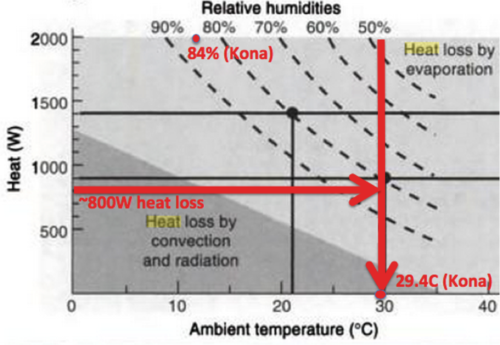
Considering the average weather in Kona, HI in October is 29.4C and 84% humidity and stays at a remarkable narrow band over the years, I estimated what happens if you run at 2:50 marathon pace in these conditions by using Noakes’ cooling model and adjusting it based on body size (skin area):
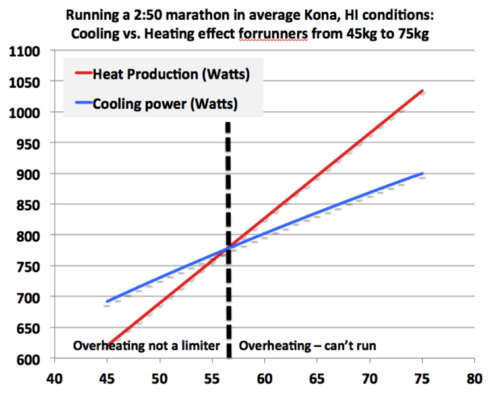
It looks like a 55-60kg (120-130lbs) runner is not going to be limited by heat for a 2:50 marathon, but anyone larger than that will suffer and overheat at that pace based on average athlete’s heat loss (cooling ability).
So the obvious question is how fast can a runner of size X run in the Kona, HI conditions. Based on the above assumptions and also including a +8% heat acclimatization factor that has been show at least in some studies, I came up with the following:
From the above chart, if you dream of running a sub 3hr marathon in Hawaii, you shouldn’t be larger than about 72kg (or 160 pounds). For reference, the 2:50 marathon women’s record holder weighs about 52-53kg and many of the top men in the 60-65kg range for this event.
So what’s the take-away for someone racing in Hawaii Ironman and hoping to run really fast?

However, there are a few fundamental factors that change the limits of endurance performance at the Hawaii Ironman triathlon significantly and thus make certain athletes much more likely high performers in such conditions. Having just raced at that event the 7th time and seen many write-ups about “optimal pacing in Hawaii” or “how much slower you should expect to go in Hawaii” type of articles, I thought it would be interesting to look at the very specific reasons why Hawaii is different and why race pace recommendations based on “averages” is quite useless.
Human endurance performance is limited by many factors, many of which are still debated and whether it is our brain (=the central governor theory) or our failing peripheral muscles (=the cardiovascular model) that slows us down to our maximum sustainable speed. However, it is widely agreed that extreme heat and humidity negatively affect performance at maximum efforts. Interestingly, heat and humidity doesn’t slow down much if at all in the swim and bike portion of triathlon, which I’ve personally experienced and race simulation research in heat shows that too. So something different happens during the run.
Our bodies and brain try to avoid the destiny of eggs on a hot frying pan and there are two key factors pushing us away and towards this homeostasis while running:
- Heating power that is the result of our human
inefficiency. For every 1000kcal we metabolize, we only use about
200kcal (or 20%) to the forward moving motion. The rest is wasted as
heat. (Roughly the same applies to cycling too, a cyclist pushing a
bicycle forward at 300 watts is actually generating more than 900W of
heat in addition to that forward moving power) Interestingly the energy cost of running
is independent of our running pace. It takes about 1kCal per body kg to
run 1km, regardless of running pace or body size. The consequence of
this is that the heating power rapidly increases as you run faster and as you add weight.
As an example, a 50kg person running a 2:50 marathon “only” needs to get rid of 750Watts of continuous heating. Meanwhile, a 65kg person can only run a 3:40 marathon at the same waste heat level. Fortunately, our bodies can get rid of some of the excess heat, so heat doesn’t always become the performance limiter. - Cooling power that is primarily a function of convectional cooling and sweat evaporation (not just sweating) from skin. Unfortunately cooling power does not increase at the same rate with excess heat production, as cooling is more closely related to human skin surface area than weight. Secondly, cooling is also very sensitive to ambient temperature and humidity.
So the bad news is that at some running speed, runners should theoretically hit the point at which heating power exceeds cooling power, (soon) after which our bodies either shut down or turn into eggs on a frying pan. This almost never happens in cycling - unless climbing a very steep hill at walking/running pace - because at 20-40mph speed the cooling effect easily exceeds the extra heat generated.
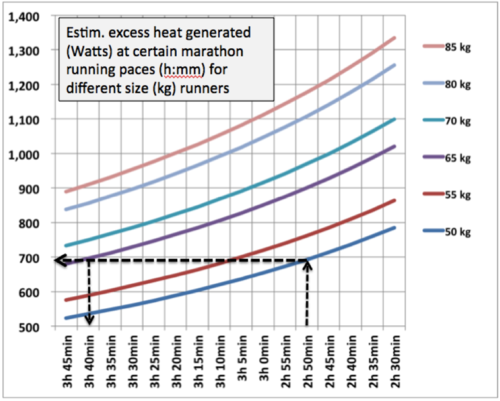 |
| Wasted heat production (in watts) at certain marathon running paces for athletes of different sizes (weight, kg). Assumes that heat power equals 80% of the total energy metabolized for the movement. |

Considering the average weather in Kona, HI in October is 29.4C and 84% humidity and stays at a remarkable narrow band over the years, I estimated what happens if you run at 2:50 marathon pace in these conditions by using Noakes’ cooling model and adjusting it based on body size (skin area):

It looks like a 55-60kg (120-130lbs) runner is not going to be limited by heat for a 2:50 marathon, but anyone larger than that will suffer and overheat at that pace based on average athlete’s heat loss (cooling ability).
So the obvious question is how fast can a runner of size X run in the Kona, HI conditions. Based on the above assumptions and also including a +8% heat acclimatization factor that has been show at least in some studies, I came up with the following:
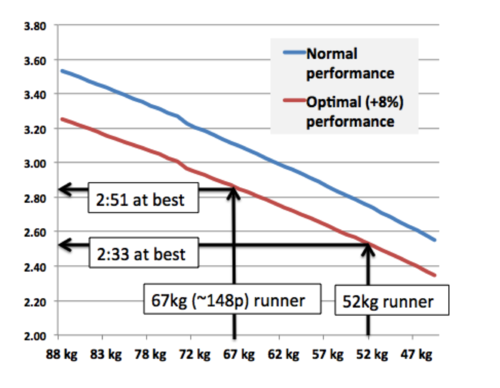 |
| Estimated best possible marathon performance in Hawaii Ironman based on heat as the limiting factor for different size runners. |
From the above chart, if you dream of running a sub 3hr marathon in Hawaii, you shouldn’t be larger than about 72kg (or 160 pounds). For reference, the 2:50 marathon women’s record holder weighs about 52-53kg and many of the top men in the 60-65kg range for this event.
So what’s the take-away for someone racing in Hawaii Ironman and hoping to run really fast?
- Unless you’re very small (under 55-60kg) heat is likely going to be a significant performance limiter on the marathon run (not bike or swim) assuming you’re well trained to run fast otherwise.
- Acclimatize and cool as much as you can on the run.
- Hope for a cool and windy day on the run.
- Watch someone like Mirinda Carfrae (52kg) run really fast every time despite the weather conditions in Kona.

No comments:
Post a Comment